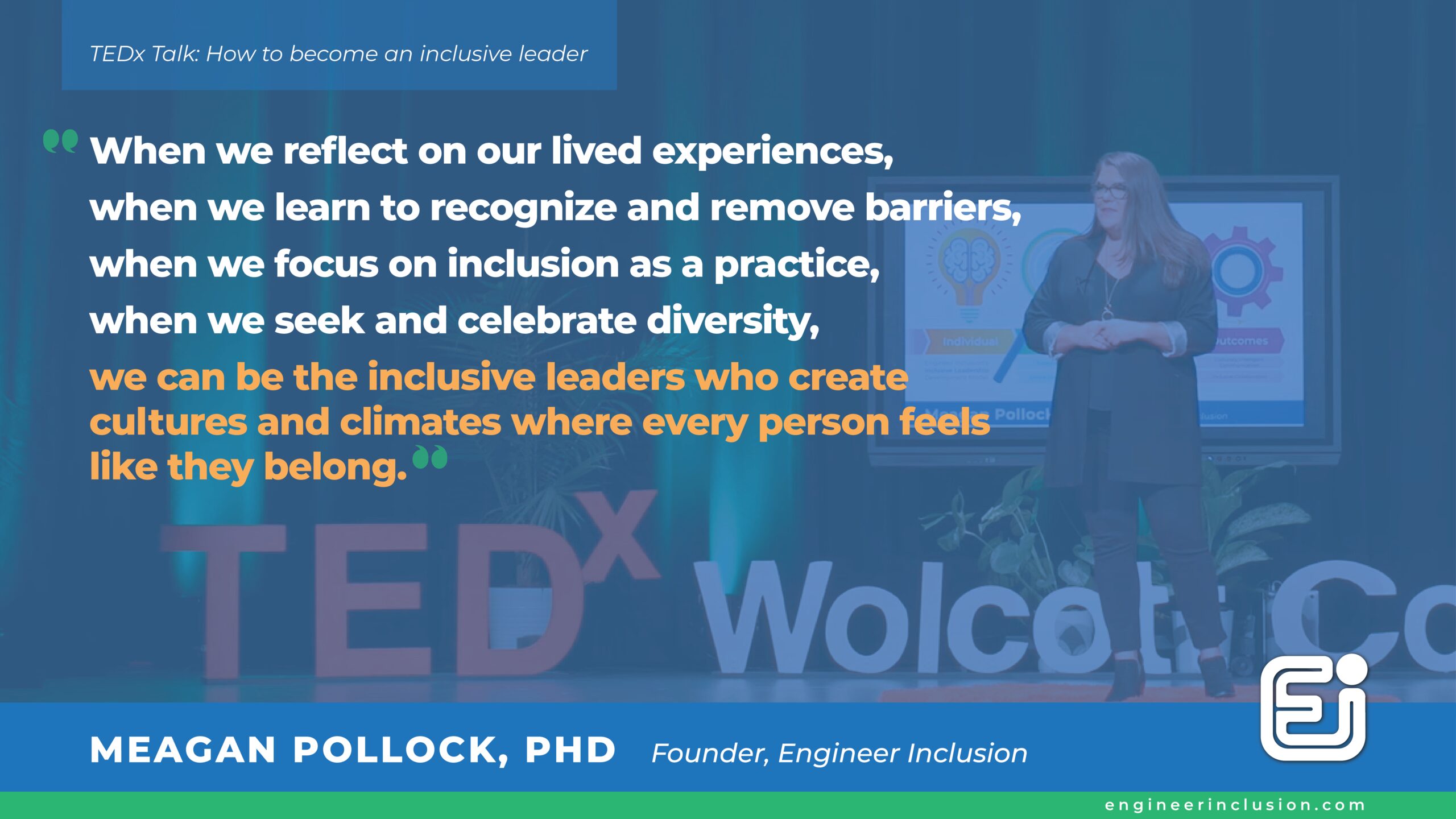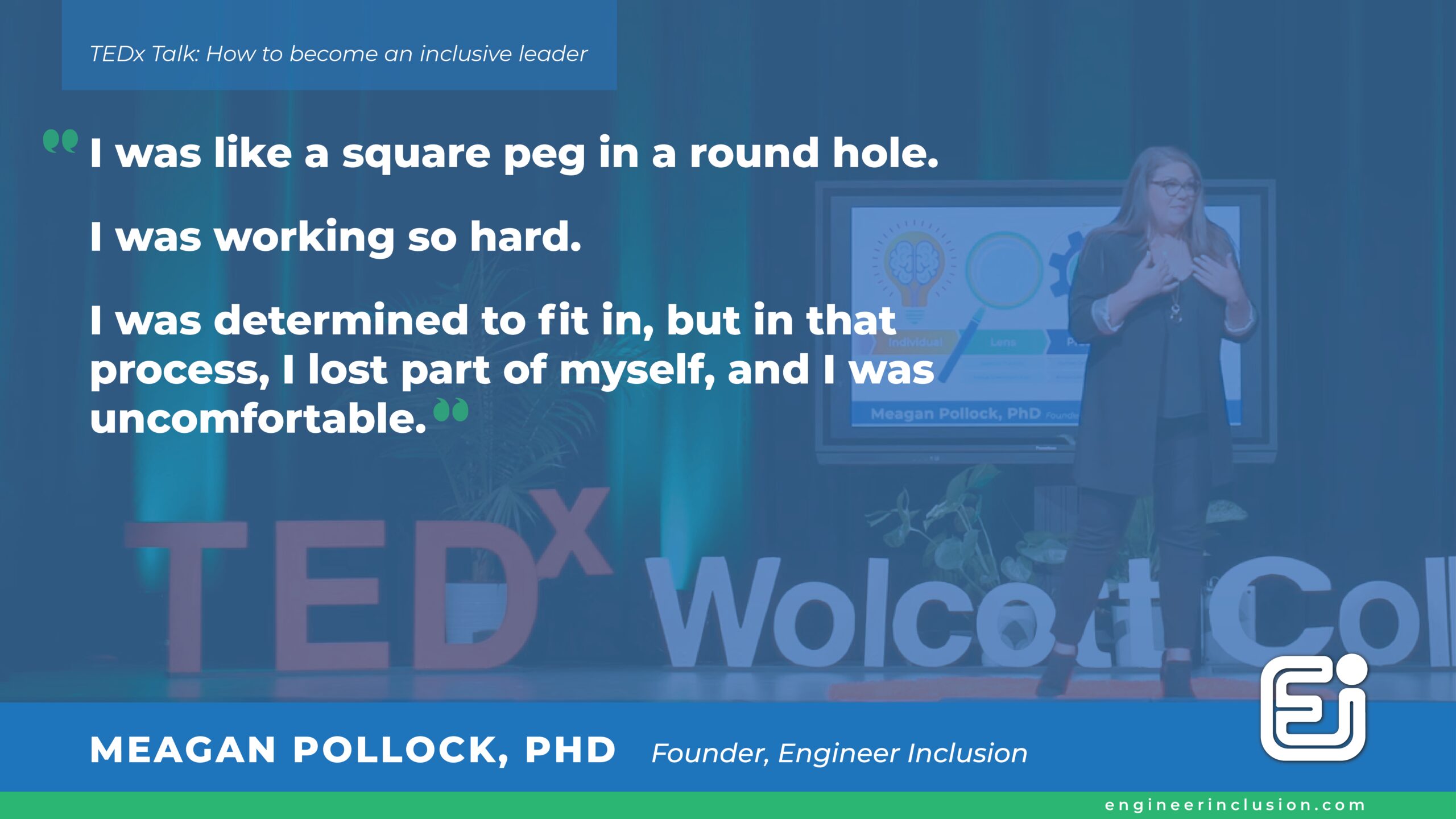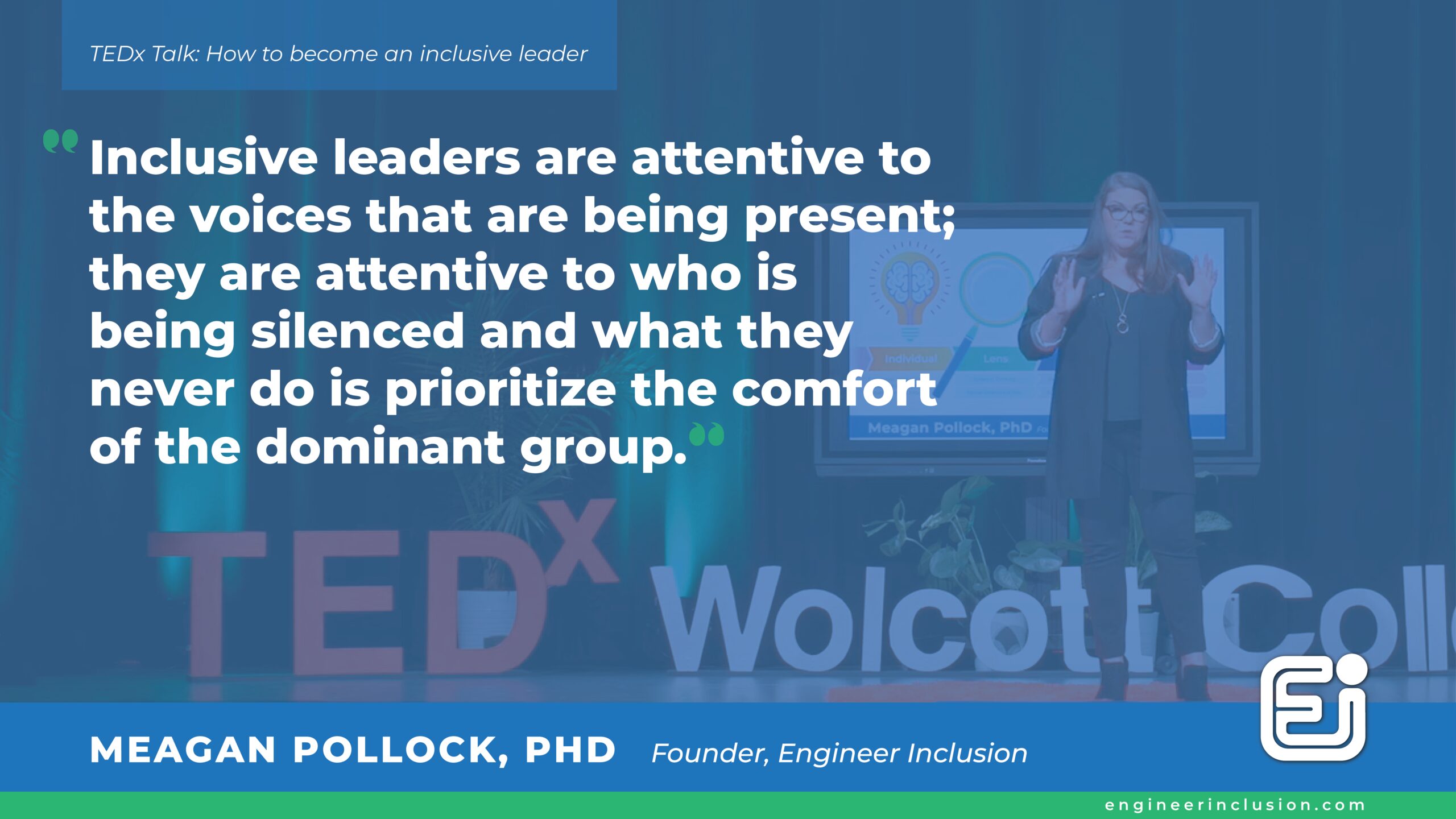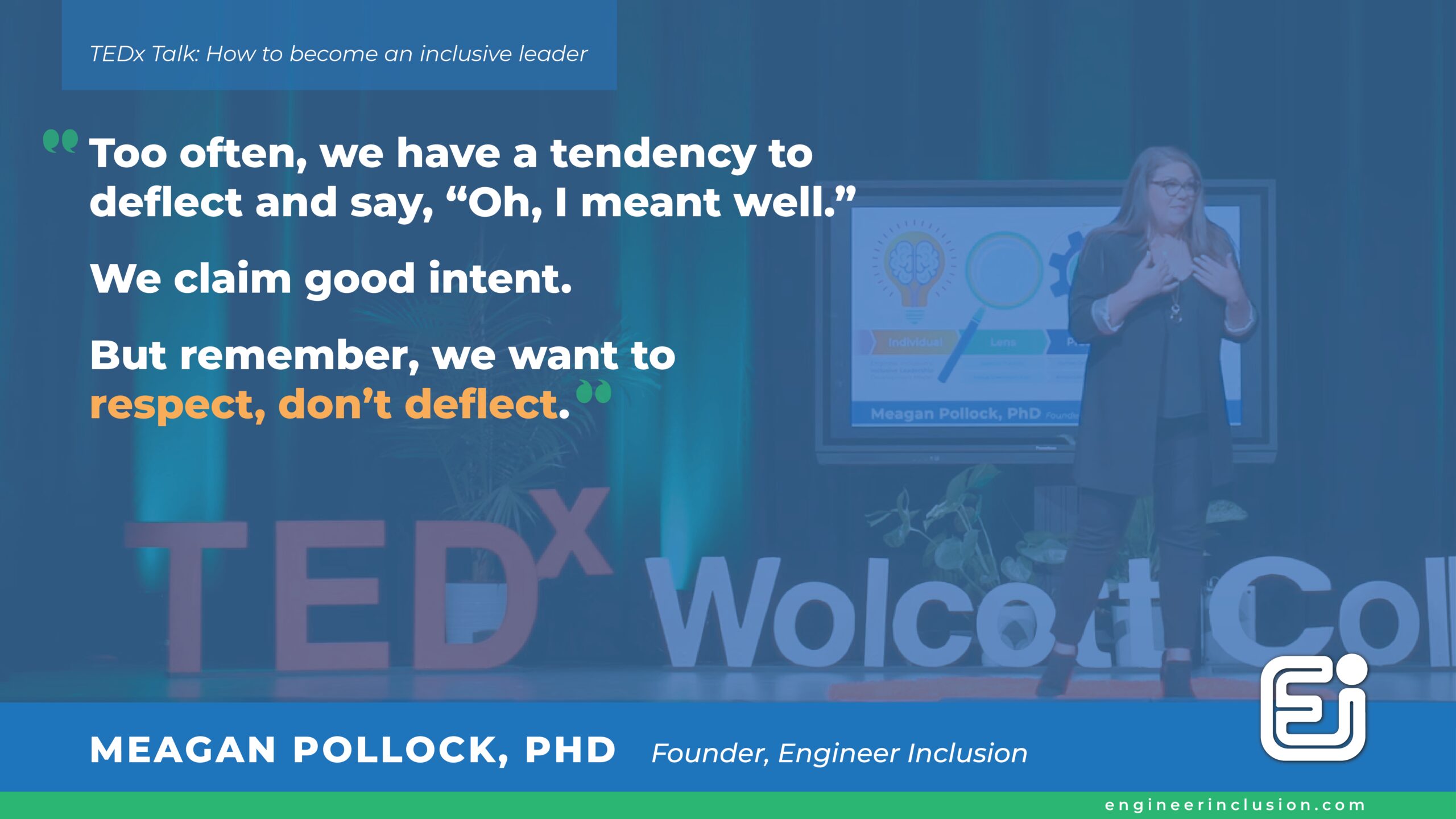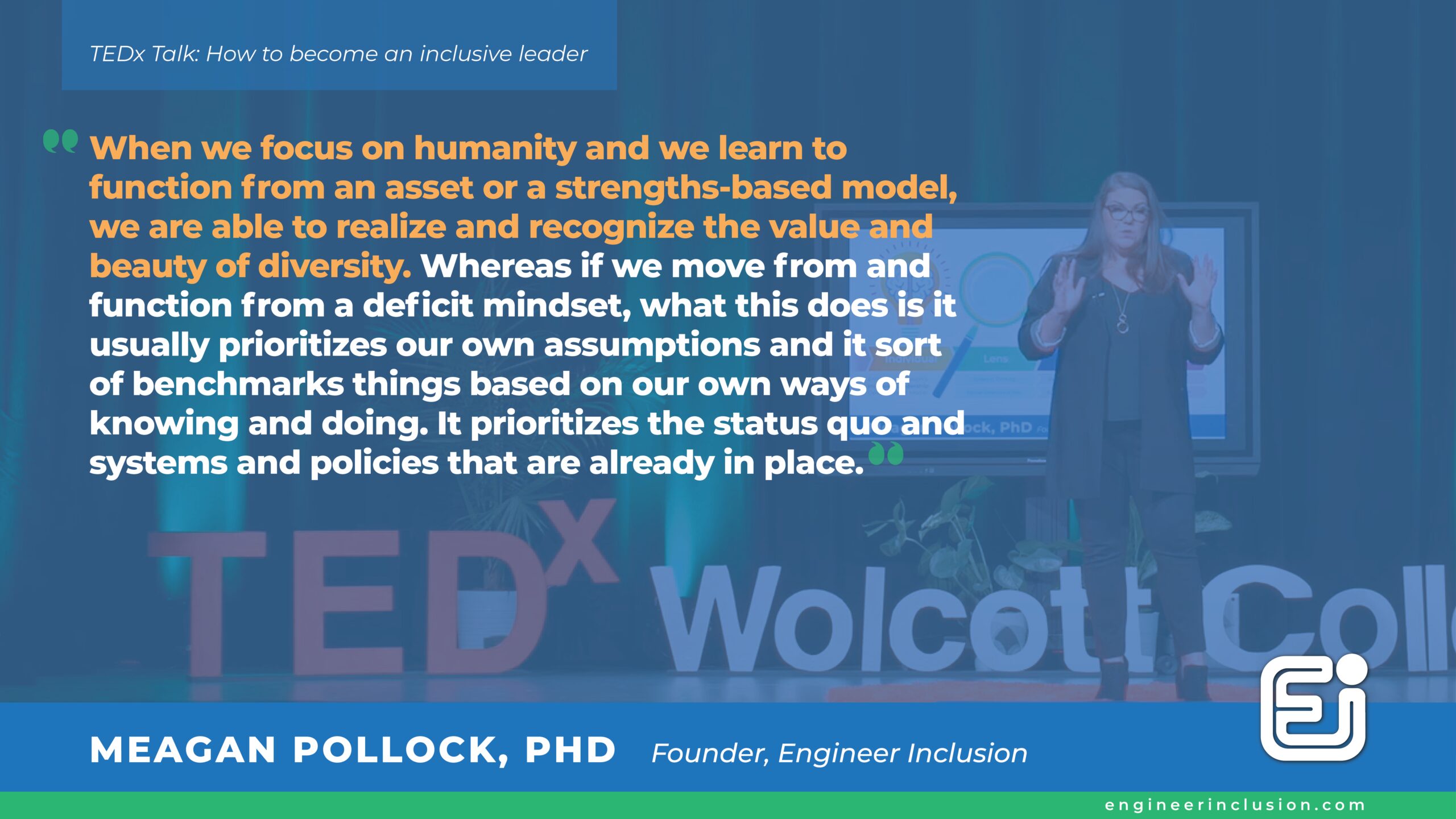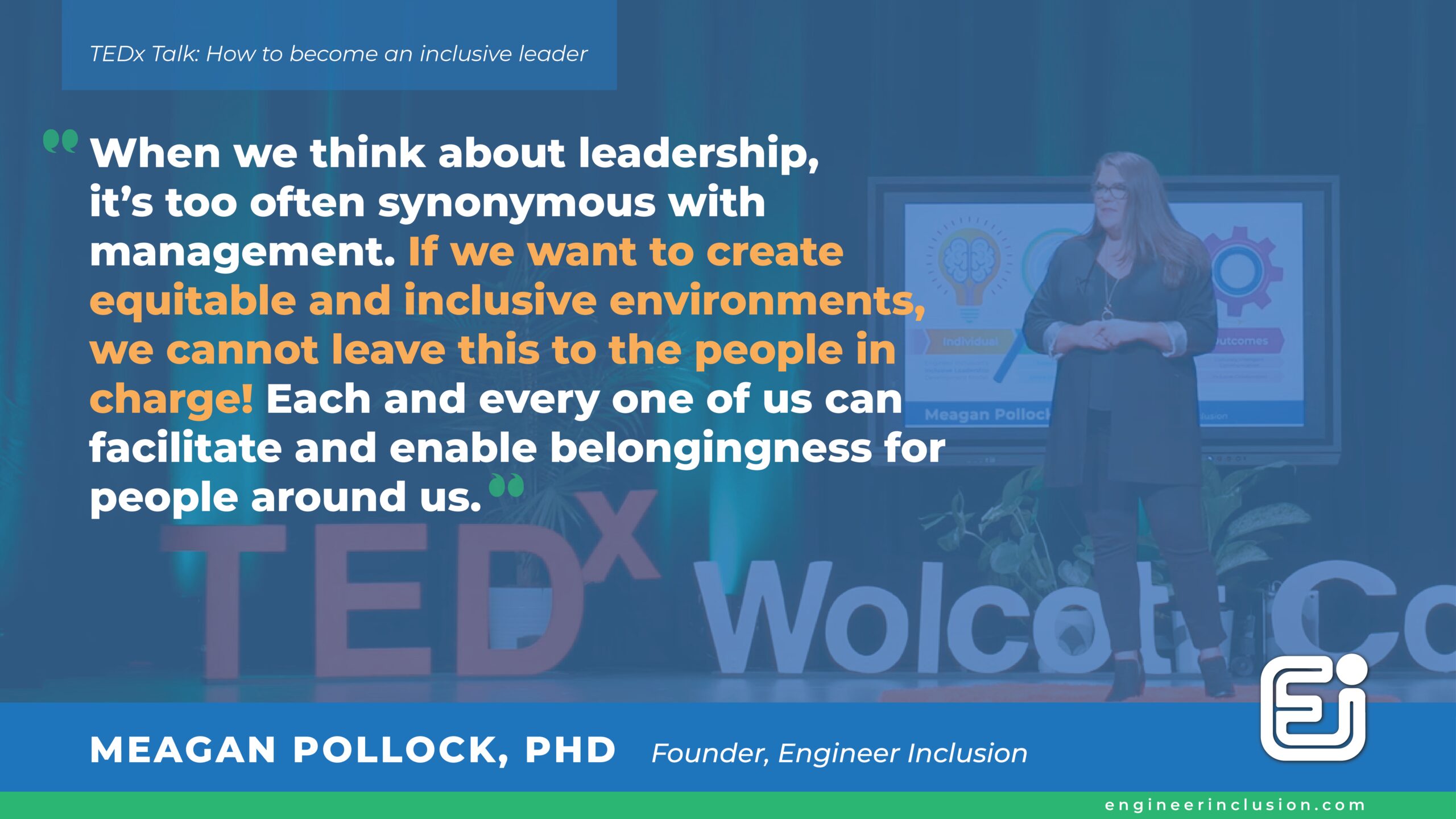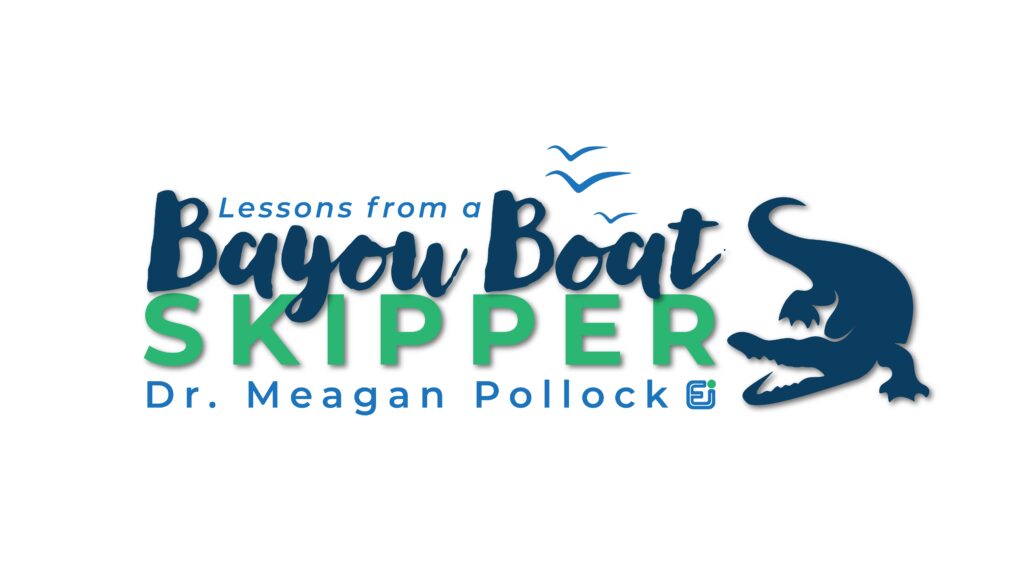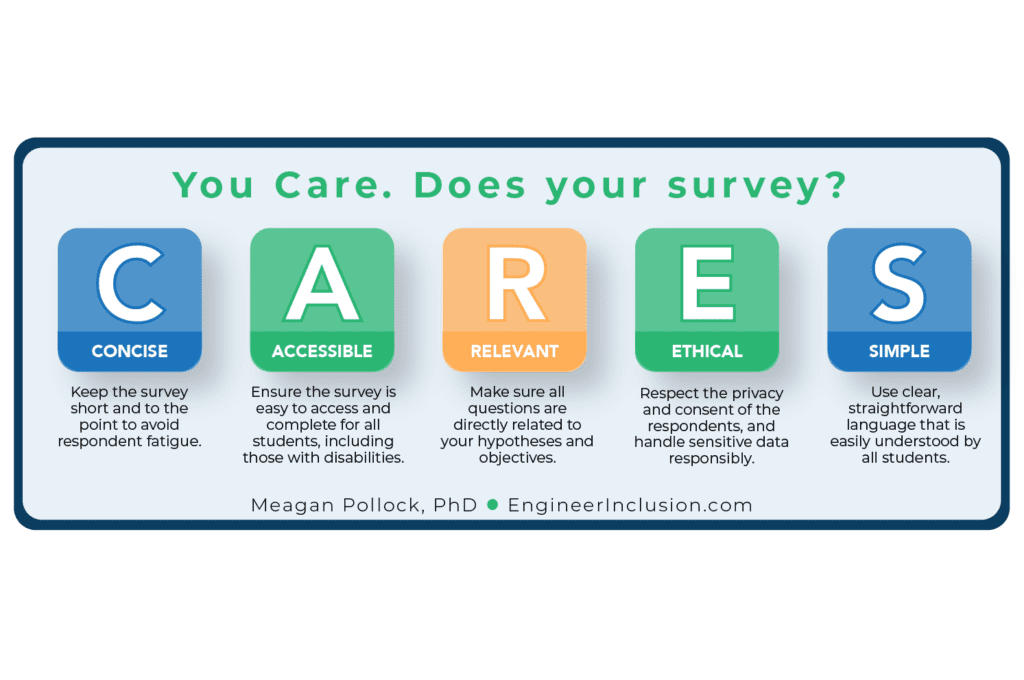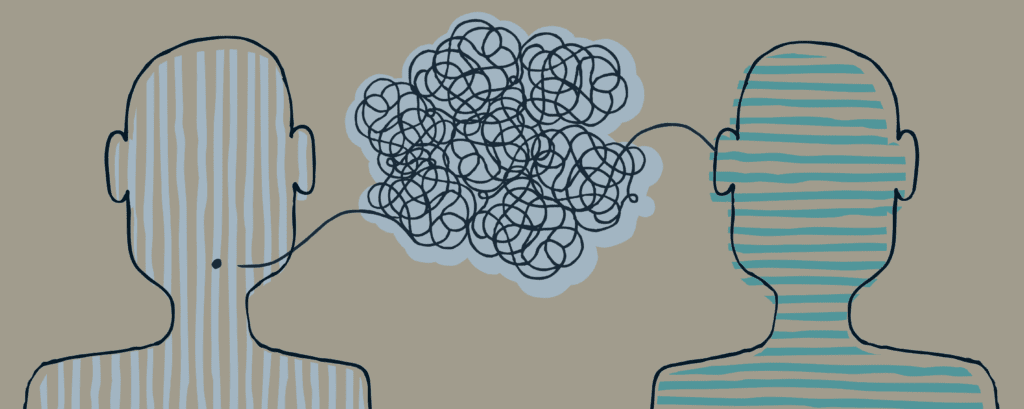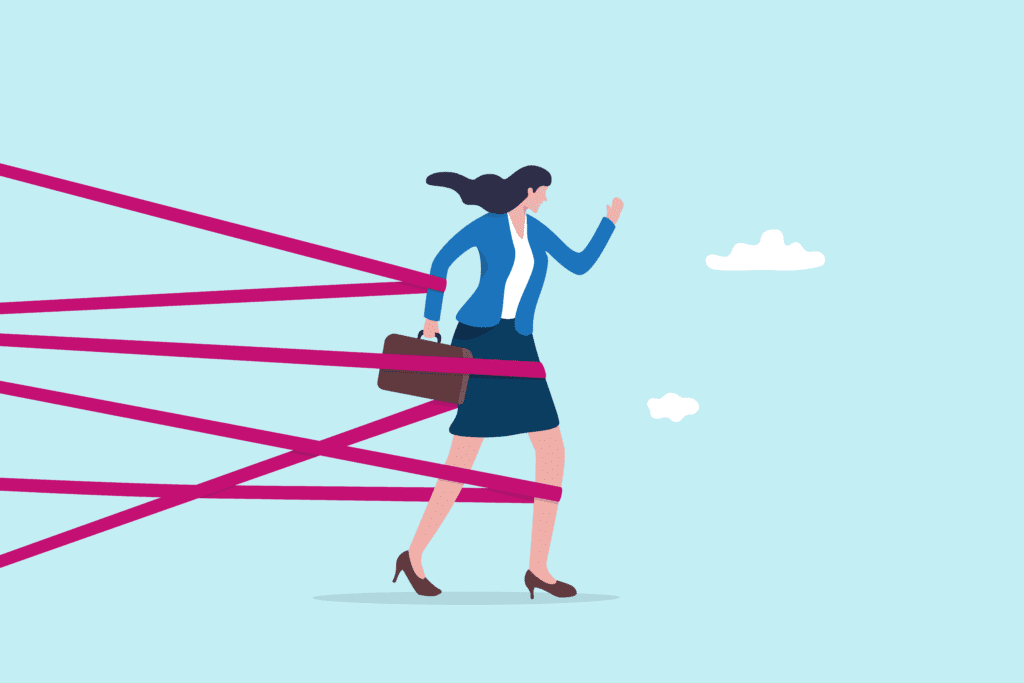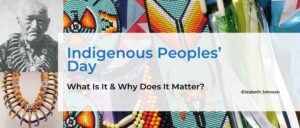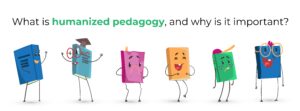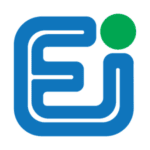On October 25, 2021, I accomplished a life goal– to give a TEDx talk. The event was hosted by Wolcott College Prep in Chicago, and I couldn’t be happier with the result! It is 11 minutes, and you won’t regret learning “how to become an inclusive leader.”
Transcript
On my first day as a full-time engineer, an unexpected challenge dared me in the hallway. I ran into a colleague from my internship, and he asked, “Meagan, what are you doing here?” I was pretty excited, it was my first day, after all, and I said, “It’s my first day.” And he looked back at me and his brow furrowed, and he snarled, and he said, “You don’t deserve to be here. You were only hired because you’re a pretty little girl.”
Now, I don’t remember how I responded, but I can be sure that it was with caution. At that time in my life, I didn’t have the vocabulary, I didn’t have the words, and I definitely didn’t have the confidence or courage to speak truth to power. I knew I deserved to be there. I knew that I had earned my place on my own merit, but what he planted that day was a heavy seed of doubt.
It was almost like a little devil on my shoulder. So whenever I ran into—one of the countless times when I felt like I didn’t belong in industry, there the doubt was, reminding me that I didn’t belong.
Fast forward a couple of years, and I was working on my Ph.D. When I started, my mission was, and remains, to change the culture of engineering. Because of that shift, I was invited to speak at the Engineers Without Borders conference in Canada.
I was new to the group, so I showed up a little bit early to kind of get a feel for the audience. And as I sat down in the room, people filtered in, and I had a great conversation with the people at the table around me.
Then the lights dimmed, and the conference kicked off. Speaker, after speaker, I was inspired. I was in wonder at all of the amazing stories these engineers told of the impact of their work.
All of a sudden, a powerful feeling washed over me. I had chills. Bewildered, I looked around me, and the first thing I noticed was everyone at my table presented as a woman.
Then it dawned on me that not once during our conversation did we talk about work-life balance or personal branding or how to survive in a man’s world. Those were the typical conversations that I was familiar with when women in engineering got together.
So then I looked around the room, and it was a sea of faces of different races, nationalities, ages, lots of different backgrounds. So I turned back into the stage, and at that point, I was able to pinpoint the feeling. The feeling was belonging.
It was the first time in my, at that point, ten-year journey to becoming and being an engineer that I felt like I belonged. I also felt valued because I had been invited to speak, and I was startled because my identity as an engineer finally felt affirmed.
Belonging and feeling valued are fundamental human needs. When we look at Maslow’s hierarchy of needs, belonging is smack dab in the middle. We’ve got to take care of safety and food, all of those things first, but then it [belonging needs] takes precedence. Belonging and those needs of love and belonging take precedence over self-esteem and self-actualization.
People need to perceive that they are a valued member of a team, and they need to experience treatment that meets their needs for belongingness and uniqueness in the workplace or in pathways to the workplace.
Inclusive leadership can meet these two needs, not to mention it can also improve attendance, performance, collaboration, and it can reduce turnover.
Now, when we think about leadership, it’s too often synonymous with management, and if we want to create equitable and inclusive environments, we cannot leave this to the people in charge. Each and every one of us can facilitate and enable belongingness for people around us.
When we think about leadership, it's too often synonymous with management. If we want to create equitable and inclusive environments, we cannot leave this to the people in charge! Each and every one of us can facilitate and enable belongingness for people around us.
Dr. @MeaganPollock Tweet
I want to introduce you to a model. It’s a process, and it is the inclusive leadership development model. And it originates from, I pulled together engineering education standards to create this for engineering leadership development courses, but it also creates a nice visual for anyone who is interested in becoming and developing into an inclusive leader.
Part 1 of the Inclusive Leadership Development Model
The first part of the model is the individual, the self, it’s us, it’s you, right? And so, to start this off, I have a confession to make. I was 28 years old when I learned the difference between gender and sex. I was 28 when I learned that gender and race are social constructs. Again, 28 when I learned what white privilege was. This new knowledge, this new awareness, created a remarkable journey for me of uncovering and exploring who I was and how my lived experiences influenced how I saw and moved through the world.
It’s so important for us to understand our identities because it changes how we filter and how we perceive everything in the world.
You can also think of this as sort of like learning to move through life with a mirror. This mirror, it helps you look at yourself and your reactions in relation to the experiences and the realities of other people.
It's so important for us to understand our identities because it changes how we filter and how we perceive everything in the world. You can also think of this as sort of like learning to move through life with a mirror. This mirror, it helps you look at yourself and your reactions in relation to the experiences and the realities of other people.
Dr. @MeaganPollock Tweet
Part 2 of the Inclusive Leadership Development Model
Now, the second part is a lens. So part one it’s looking in, and part two is looking out. Now, at 28, I didn’t have this sort of startling awakening. It was a very subtle time of, you know a long journey of learning and having lots of really uncomfortable moments as my lived experiences—as I realized how they had blinded me from seeing the experiences of other people.
But this social consciousness, what it allowed me, I firmly believe that it has allowed me to be a kinder, more empathetic, compassionate human. And that’s because I have learned to see discrimination. I have learned to recognize prejudice and bias. I have learned to see the barriers that other people face that I may not have because of my own lived experiences.
The two key pieces of this part of the lens are learning to develop systemic thinking and developing a true passion for the ethical dilemma of bias, both interpersonal and institutional.
Part 3 of the Inclusive Leadership Development Model
Now, we can learn all the things about ourselves, and we can learn different ways of looking at the world, but unless we take action, it’s all useless, right? So there are two key practices that we want to learn. The first is a human-centered approach, and the second is becoming an accountable, lifelong learner.
When we focus on humanity and we learn to function from an asset or a strengths-based model, we are able to realize and recognize the value and beauty of diversity. Whereas if we move from and function from a deficit mindset, what this does is it usually prioritizes our own assumptions and it sort of benchmarks things based on our own ways of knowing and doing. It prioritizes the status quo and systems and policies that are already in place.
When we focus on humanity and we learn to function from an asset or a strengths-based model, we are able to realize and recognize the value and beauty of diversity. Whereas if we move from and function from a deficit mindset, what this does is it usually prioritizes our own assumptions and it sort of benchmarks things based on our own ways of knowing and doing. It prioritizes the status quo and systems and policies that are already in place.
Dr. @MeaganPollock Tweet
Now, the second piece is being an accountable, lifelong learner, and I want to focus on the first word. It’s so important that as leaders, that we are accountable on our journey because you are bound to make tons of mistakes and mishaps because as our social consciousness expands, you are learning more and recognizing and seeing more about the experiences of other people. We have to respond because if we don’t, we aren’t able to respect the dignity of the humans that we serve. By not responding, by not taking accountability, we aren’t able to serve those people for whom we may have harmed.
It’s also important that we have accountability because it reinforces a growth mindset that the journey to becoming an inclusive leader or by incorporating inclusive practices, it is that, a practice. So we want to model that. Too often, we have a tendency to deflect to say, “Oh, I meant well.” We claim good intent. But remember, we want to respect, don’t deflect.
Too often, we have a tendency to deflect and say, "Oh, I meant well." We claim good intent. But remember, we want to respect, so don't deflect.
Dr. @MeaganPollock Tweet
Part 4 of the Inclusive Leadership Development Model
So the next piece are the outcomes, right? It’s what we want as a result of this process and continuum. Again, a very iterative process. And there are two key pieces here. First, it’s culturally intelligent communication, and the second is inclusive collaboration.
Now—communication and collaboration—these directly influence the culture and climate of an environment, which then is directly correlated to the level of belongingness that people experience. And so, all people from non-dominant groups experience marginalization and exclusion. So whether by race, gender, class, ability, disability, sexuality, nationality, religion, language, any person who is from a group that isn’t the one who typically has power and influence they’re going to experience marginalization and exclusion. But if we create inclusive environments, it allows everyone to authentically contribute.
Inclusive leaders are attentive to the voices that are being present; they are attentive to who is being silenced and what they never do is prioritize the comfort of the dominant group.
Inclusive leaders are attentive to the voices that are being present; they are attentive to who is being silenced and what they never do is prioritize the comfort of the dominant group.
Dr. @MeaganPollock Tweet
So when we have the combination of diverse perspectives and lived experiences, we are able to shift the norm. We are able to shift it so that everyone can authentically engage.
Conclusion
When I left industry, I began to conceive how inauthentic I had become in an effort to survive in that space. Most importantly, I recognized that I no longer had to care or watch football because otherwise—I had to, that was the only way I could talk to my colleagues. As someone—a Texan—who was raised under Friday night lights, this is particularly liberating. But what had happened is—I was like a square peg in a round hole. I was working so hard, I was determined to fit in, but in that process, I lost part of myself, and I was uncomfortable.
I was like a square peg in a round hole. I was working so hard, I was determined to fit in, but in that process, I lost part of myself, and I was uncomfortable.
Dr. @MeaganPollock Tweet
So in this sort of unveiling, post assimilation, it’s been a bit bittersweet for me, but it is what drives me to do this work. At this point in my life, I have switched from widgets to workshops, and it is such a joy to work with people, to engineer equity and inclusion into their organizations, and it’s remarkably rewarding. It is also a very cathartic thump to the devil of doubt on my shoulder.
I want to invite you to join me on this journey because:
- when we reflect on our lived experiences,
- when we learn to recognize and remove barriers,
- when we focus on inclusion as a practice,
- when we seek and celebrate diversity,
- we can be the inclusive leaders who create cultures and climates where every person feels like they belong.
When we reflect on our lived experiences, when we learn to recognize and remove barriers, when we focus on inclusion as a practice, when we seek and celebrate diversity, we can be the inclusive leaders who create cultures and climates where every person feels like they belong.
Dr. @MeaganPollock Tweet


